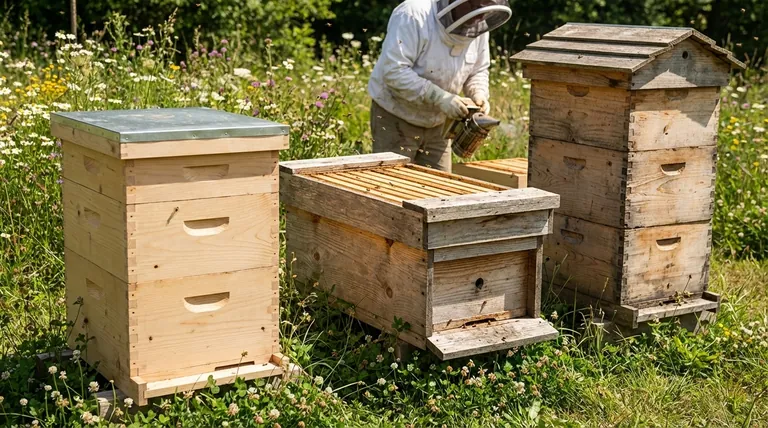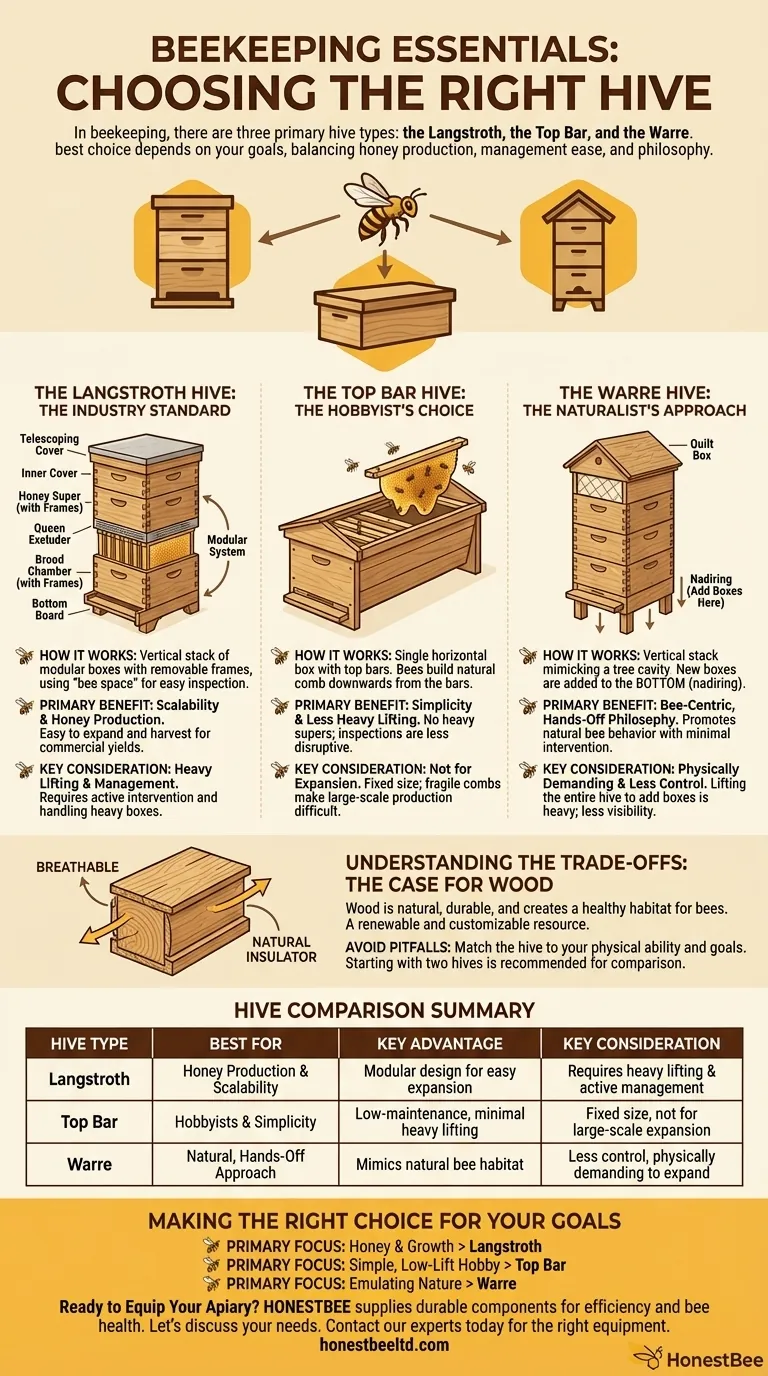In beekeeping, there are three primary hive types you will encounter: the Langstroth, the Top Bar, and the Warre. The Langstroth hive is the most common, a modular system ideal for honey production and scalability. The Top Bar hive is a simpler, horizontal hive favored by hobbyists, while the Warre hive is a vertical, more hands-off hive designed to mimic a natural bee habitat.
The "best" beehive does not exist. The right choice is a direct reflection of your beekeeping goals, balancing honey production, ease of management, and your philosophy on interacting with the bees.

The Langstroth Hive: The Industry Standard
The Langstroth hive is the most recognizable and widely used beehive in the world, especially in commercial operations. Its design is based on the principle of "bee space," allowing for easy removal and inspection of frames.
How It Works: A Modular System
A Langstroth hive is a vertical stack of boxes, often called supers. Inside each box, removable frames hang vertically, providing a structure for the bees to build their comb.
These hives typically come in eight-frame or ten-frame configurations. The boxes themselves come in varying depths (deep, medium, or shallow) to serve different purposes, from the deep brood chamber to shallower honey supers.
Primary Benefit: Scalability and Honey Production
This modular design is its greatest strength. You can easily add or remove boxes to give the colony more space or to harvest honey, making it ideal for beekeepers who plan to expand. This efficiency is why it's the standard for maximizing honey yield.
Key Consideration: Heavy Lifting and Management
Managing a Langstroth hive is a hands-on process. Regular inspections are necessary, and a super full of honey can be extremely heavy. It is a system built for active management, not for a hands-off approach.
The Top Bar Hive: The Hobbyist's Choice
The Top Bar hive offers a simpler, more contained approach to beekeeping, making it popular with backyard hobbyists who are less focused on large-scale honey production.
How It Works: A Horizontal, Natural-Comb Design
This hive is a single, long horizontal box with simple bars laid across the top. Bees build their comb naturally, drawing it down from the center of each bar without the guidance of a full frame or foundation.
Primary Benefit: Simplicity and Less Heavy Lifting
Because it is a single box, there are no heavy supers to lift. Inspections are done one bar at a time, which is much less disruptive to the colony and easier on the beekeeper's back.
Key Consideration: Not Designed for Expansion
The fixed size of a Top Bar hive makes it unsuitable for large-scale operations or significant expansion. Honey harvests are typically smaller and the free-form comb can be more fragile to handle.
The Warre Hive: The Naturalist's Approach
The Warre hive is often seen as a middle ground between the Langstroth and the Top Bar, designed to mimic the vertical cavity of a tree trunk and promote natural bee behavior.
How It Works: A Vertical Hive with Bottom-Boxing
Like a Langstroth, the Warre is a vertical stack of boxes. The key difference is that new boxes are added to the bottom of the stack, not the top. This process, called nadiring, encourages the bees to move their nest downward, just as they would in nature.
Primary Benefit: A Bee-Centric, Hands-Off Philosophy
The Warre is for beekeepers who want to intervene as little as possible. The design philosophy prioritizes the colony's natural rhythms and well-being over maximizing honey production.
Key Consideration: Physically Demanding and Less Control
While management is less frequent, adding a new box requires lifting the entire existing hive stack, which can be very heavy. This hands-off approach also means you have less control and visibility into the colony's day-to-day status.
Understanding the Trade-offs
Choosing a hive is your first major decision, and it comes with important trade-offs. The material of the hive is a primary consideration.
The Case for Wood
Wooden hives are popular for good reason. Wood is a natural insulator and is breathable, helping to create a healthy and comfortable habitat for the bees.
With proper maintenance, a wooden hive is highly durable and can last for many years. It is also a renewable resource and can be easily customized or repaired.
Common Pitfalls to Avoid
The biggest mistake a new beekeeper can make is choosing a hive that doesn't match their physical ability or long-term goals. Choosing a Langstroth when you cannot lift heavy boxes, or a Top Bar when you dream of selling honey, will lead to frustration. It's often recommended to start with two hives, regardless of type, to allow for comparison and to troubleshoot issues by sharing resources between colonies.
Making the Right Choice for Your Goals
Your beekeeping philosophy is the most important factor. Answering why you want to keep bees will point you to the correct hive.
- If your primary focus is honey production and future growth: The modular and efficient Langstroth hive is the clear, proven choice.
- If your primary focus is a simple, low-lift hobby experience: The Top Bar hive offers an accessible and natural starting point with minimal heavy lifting.
- If your primary focus is emulating nature with minimal intervention: The Warre hive is designed specifically for a hands-off, bee-centric philosophy.
Ultimately, select the hive that best aligns with the kind of beekeeper you want to become.
Summary Table:
| Hive Type | Best For | Key Advantage | Key Consideration |
|---|---|---|---|
| Langstroth | Honey Production & Scalability | Modular design for easy expansion | Requires heavy lifting & active management |
| Top Bar | Hobbyists & Simplicity | Low-maintenance, minimal heavy lifting | Fixed size, not for large-scale expansion |
| Warre | Natural, Hands-Off Approach | Mimics natural bee habitat | Less control, physically demanding to expand |
Ready to Equip Your Apiary with the Right Hive?
Choosing the right hive is the first step to a successful beekeeping operation. HONESTBEE supplies the durable equipment and supplies—from Langstroth hive components to protective gear—that commercial apiaries and distributors rely on for efficiency and bee health.
Let's discuss your specific needs. Contact our wholesale experts today to get the right equipment for your scale and philosophy.
Visual Guide

Related Products
- Langstroth Bee Hives Bee Keeping Box for Beginners Beekeeping
- Langstroth Honey Bee Box Hive Boxes for Different Depths
- Long Langstroth Style Horizontal Top Bar Hive for Wholesale
- HONESTBEE Professional Multi-Functional Hive Tool with Ergonomic Wood Handle
- Multi-Functional Sliding Hive Entrance for Beekeeping
People Also Ask
- How does the ease of access differ between 8-frame and 10-frame hives? Choose the Right Hive for Your Body
- Why were wooden hives traditionally preferred? For Natural Beekeeping Aligned with Bee Biology
- What are the key features of the Langstroth beehive? A Guide to the Standard for Modern Beekeeping
- What are the different types of beehive boxes available? Choose the Right Hive for Your Apiary
- Why might a beginner be advised to start with a Langstroth hive? Unlock a Supportive Beekeeping Ecosystem



















